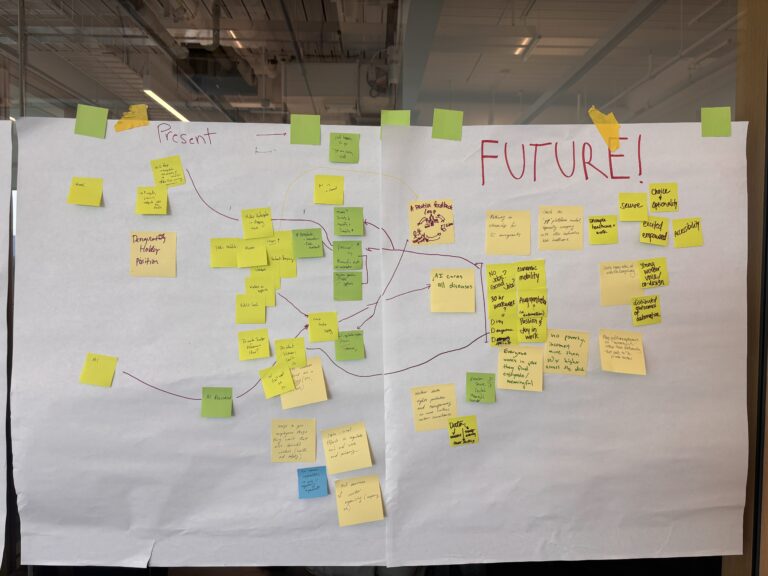What happens when scale is the part of the goal, rather than a fortunate result?
Achieving impact at scale is a perennial challenge across the social sector, including for nonprofits and philanthropy. An oft-cited reason is lack of resources: the challenge of matching the ambition of goals to available dollars. This challenge may manifest itself as a practical tradeoff between resource intensity on a narrow issue and breadth across many areas. Sometimes scale is limited by a lack of ambition. Other times, it’s the opposite: misunderstanding the severity, complexity or entrenchment of problems can constrain efforts at change. Underlying all of this, impact at scale can be limited by the resilience of social, political, and economic systems and their interest in the status quo.
At Siegel Endowment, we fund and test many promising ideas that we hope can make a wide-reaching societal impact. Too often, we’ve seen organizations become victims of their own success, struggling to respond and expand just when they seem to have gotten the flywheel going.
We don’t mean to suggest that scale is the only way to solve problems; indeed there are many ways to grow and deepen impact. But for those that seek it, scale shouldn’t be a surprise. By thinking about scale from the start, we can design programs that are prepared for the challenges of expanding their reach and delivering broader social change.
While there is no one true path to scale, this series will provide an overview of the ways we’re approaching questions of scale. We will dig into some of the ways our grantee partners have incorporated scale as one of their core design tenants.
Common Barriers to Scale
There are many pathways to scale; growth, replication, transfer, removing structural barriers, shifting perceptions, developing tools that can be widely disseminated, funding research to inform decisions, and more all factor into the conversation. However, not all of these pathways are viable in all contexts.
For example, many philanthropic initiatives aim to reach scale by replication of a particular solution. Once a solution or intervention is piloted and shown to be effective in one place (such as in one school, one city, or one training facility) the intervention is then replicated elsewhere. There are pros to replication. The production of handbooks, “train the trainers”, lessons-learned guides, etc., can lower costs through efficiencies up to a point. However, there are also drawbacks. Replication not only multiplies the scope of the intervention, but also may multiply the costs and require additional source of funds (either public or private) to grow and sustain the scale. Furthermore, context is king. You have to pay attention to the conditions where replication might be successful, and when to look for other means.
A second example pathway to scale is to act on a key leverage point in a system, such as the removal of an important barrier or strategic use of a positive or negative feedback loop. A subclass of this theory is that complex systems that evolve over time may have one or more tipping points along their path, where a small intervention might have cascading impacts. While appealing as a concept, this approach can have pitfalls, too. There is uncertainty in our ability to identify those levers and tipping points and what it takes to move them. We often underestimate the resilience of social systems and their resistance to change. And in many cases the specific changes we seek require long-term work to reach a point where significant change becomes possible.
A third example of how many seek scale is through public policy changes. While private foundations are prohibited from lobbying, they may fund research, policy development, and policy education efforts at federal, state, or local levels. This route to scale typically involves some mix of building longer-term grassroots advocacy capacity, elite education, intensive campaigns, policy development and research, combined with pilots and demonstrations. These changes can have massive society-wide effects, but bear equally massive constraints. Policy change takes years, often with uncertain results, especially in a partisan environment that narrows the landscape of what is feasible.
In our view, there is no one “right” way to scale, and different contexts will demand different ways of thinking. It comes down to questioning not only which strategies work, but for whom those strategies work, and in which contexts?
Our Approach: Testing Many Pathways to Scale
At Siegel, we begin by asking which pathway(s) seem most viable for a particular problem, and then test our hypotheses through our grant and research investments.
For example, since our founding, we’ve aimed to improve computational thinking through computer science education and coding. From the outset, we thought explicitly about how to build a broader movement around computer science. We’ve invested heavily in student learning through platforms likeScratch and NYC FIRST. We hypothesized that new curricula and tools would help teachers, entering partnerships with Bootstrap, Alder Graduate School of Education at Stanford, Cornell Tech’s Teacher in Residence. We’ve focused on the challenging task of curriculum change in our schools, which is why we worked with systems-building organizations like CSforALL and Data Science for Everyone. And on the flip side, we’ve also focused on courses outside of traditional school, with grants to Khan Academy and other online learning platforms. Finally, we seek to establish an evidence base for the effectiveness of these programs to share across locations, working with partners like the Northeastern Center on Inclusive Computing. Our path to scaling our impact in computational thinking involved multiple types of interventions – not just one.
By supporting that effort, we were testing not just whether teaching coding was beneficial for students. We were also asking which pathways to scale are viable, under what conditions, and what could make them more so. This series will take a closer look at two strategies successfully being used by our workforce grantees today: (1) scale through existing networks, and (2) scale through initial program design.
Scale Through Existing Networks
As a national network of individual, localized hubs advising small and medium-sized manufacturers across the United States, the Manufacturing Extension Partnerships (MEPs) is already in a place to create a much-needed shift in how workers and communities participate in innovation strategies. We are supporting research at the University of North Carolina and Portland State University that looks at MEPs as labs for driving national change on the local scale. Rather than building more programs, we look at institutions that have already reached a particular scale and ask how it might be leveraged for greater impact.
Within large networks, information from disparate parts ought to provide feedback to the coordinating body of the larger system. Through fine-tuning the communication flow between independent MEP centers, we hypothesize that centers could adopt and adapt successful models, or learn from unsuccessful ones. The results of our programs could show us how small-scale feedback might catalyze big changes by transforming practices across the system.
Scale Through Program Design
Worker training programs can offer access to career paths and better paying jobs in communities that are underrepresented in more traditional educational institutions. We need to know that these programs lead to meaningful outcomes for the workers who use them. However, the scale of these programs is often constrained by rising costs to the institutions that provide them. Successful, but small, worker training programs that deliver the best impact on learners might find ways to grow and expand, only to face unsustainable costs as they reach more people.
One route around this roadblock – for institutions and learners alike – is to rethink the way these programs are financed. By designing for cost stability and/or reduction alongside growth, we obviate the resource constraints that generally come with serving additional people. We hypothesize that this can be done by both redistributing the costs and reimagining repayment so that all stakeholders – workers, workplaces, and training providers – can more equitable share the cost burden and reap rewards.
Moving the Mountain
When we only work to solve immediate problems, we focus on the granular; we try to move a mountain one rock at a time. But for large, complex problems where we seek to reach many, we have to hold the goal of scale in our minds from the very beginning. From program development and deployment to ongoing strategy adaptation to seizing policy moments – scale should be an ever-present part of the work. It’s much easier to move a mountain using coordinated group effort, environmental leverage, and heavy machinery.
The challenge for nonprofits and foundations alike is in matching the right scale strategy to the right problem. What can we learn by looking at leverage points within organizations that are already at the scale to affect massive change? How can we identify the pieces of smaller programs that won’t scale, and replace them with pieces that could? What does it look like to design for scale from the onset? The next pieces in this series will look at successfully “scaled” organizations for insights into how they work, what works, when and for who — and what challenges emerge.
This reflection was written by John Irons, Senior Vice President and Head of Research and Eryk Salvaggio, Research Communications Consultant, and edited by Laura Maher, Head of External Engagement.





